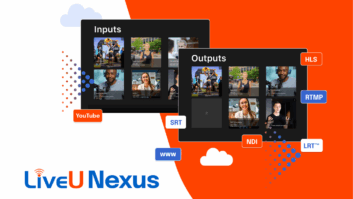As traditional broadcasters adapt to the digital era, the transition to IP infrastructure is providing the right frameworks to not only overcome legacy challenges facing the media industry but also deal with the problems of the future. Smart IP transport networks are giving media companies the capability to expand the delivery and distribution of content. The shift to IP is also laying the foundation for solutions that are having a profound impact on the industry’s workflows and operational processes. From enriching video acquisition and speeding up production to advancing targeted advertising delivery and regionalisation of content.
Intelligent IP networks designed to transport broadcast content
It is possible to transport content via IP with the same quality and reliability as satellite. However, generic IP transport solutions are generally not suitable for broadcasters, especially when carrying live and real-time video that must be reliably received and stay within a narrow latency window. That level of functionality requires a degree of ‘intelligence’ embedded into a network.
The difference between generic and intelligent IP transport networks is like comparing in-car navigation systems. Using a modern GPS that combines up-to-date maps with real-time traffic information, police, and construction-sighting reports will get a driver to their destination much faster than a standard roadmap, or an older GPS system with outdated data. Intelligent transport network solutions work in a very similar way to a modern GPS.
When broadcasters combine a fully managed service with smart multicast transport networks that work around inevitable and frequent internet ‘traffic jams,’ they can achieve flawless transmission of high-quality video content.
Driving expansion with smart IP transport solutions
Broadcasters are facing an increasingly competitive battle for eyeballs. Audiences are increasingly turning to social media sites, direct-to-consumer websites, over-the-top (OTT) platforms, and international distribution sites for content. However, broadcasters and content owners can leverage the ubiquity of the internet to extend their reach.
Research from Parks Associates has found three-quarters (76 per cent) of US households had OTT video service subscriptions, versus just 62 per cent with traditional pay-TV services in Q1 2020. And while, pay TV still dominates the sports landscape, audiences are increasingly shifting to digital video platforms as companies like Amazon, Facebook and Twitter are bidding for streaming rights for games.
The internet enables cost-effective transmission to any geographic location and destination, be it linear, OTT, or Cloud platforms. Intelligent IP transport networks allow operators to consistently distribute content with extremely high reliability and very low latency to a diverse geographic audience. Combining the ubiquity of the internet with the strengths of intelligent IP transport solutions can open up new markets for traditional broadcasters and lead to greater monetisation.
Unlocking new value from advanced advertising and regionalisation
IP will enable broadcasters to scale across multiple platforms and destinations and open up new audiences in a way that would not have been possible with satellite or dedicated fibre only delivery. Additionally, IP enabled systems can unlock workflow enhancements such as channel management, regionalisation, and dynamic ad insertion, which will drive additional value from content.
As not all programming is cleared for every region or across all delivery options (cable, satellite, internet, mobile, etc.), content replacement is often required. Tighter integrations with automation, playout, and traffic systems can streamline customising each channel delivery, per platform. Reliable, frame-accurate signaling bundled into IP delivery networks allows broadcasters to scale distribution and content replacement workflows seamlessly.
It is also possible to streamline ad delivery by integrating a dynamic metadata signaling service into the IP video stream. Such systems can allow targeted ad inventory either on a per-platform basis (MPVD set top boxes, OTT devices or Smart TVs) or ideally on a per viewer basis, where the platforms allow. Detailed ad break signaling and ad serving systems enable more intelligent decisions that drive revenue growth.
Enhancing production workflows with IP systems
Smart IP opens up new content creation opportunities for all broadcast verticals and can serve as the backbone for the future of remote production. Combining other IP-enabled tools into the production mix, such as Cloud ingest and AI/ML algorithms, will further enhance production abilities.
Cloud-based footage ingestion can enable producers to acquire unlimited concurrent live feeds from multiple contributors. The point of intake can be made from various sources, ranging from professional cameras to mobile phones or online sources. This year, the 2020 NFL Draft leveraged Cloud technology to acquire, aggregate, and manage nearly 500 live fan feeds and achieve its highest-ever ratings.
As user-generated content is on the rise, such Cloud features can enable highly agile video workflows. Additionally, Cloud applications are pioneering ways of using AI to simplify content management at scale, with initial workflows automating content identification. These systems could help follow a particular cyclist in a race or highlight a team-specific fan reaction, without having to filter through hundreds of inbound streams manually.
Winning the future of video in a digital world
The transition to IP should not be thought of as merely a replacement for the way content is transported. Smart IP multicast transport networks can help broadcasters expand their audience reach. IP solutions can open the door to a raft of new monetisation opportunities, through greater regionalisation of content, better customisation, and targeting capabilities, IP systems can deliver new value to broadcasters. Additionally, IP systems embedded into production workflows can create significant enhancements to how content is acquired, managed, and produced. For broadcasters, IP is the foundation for a bridge to the future.







